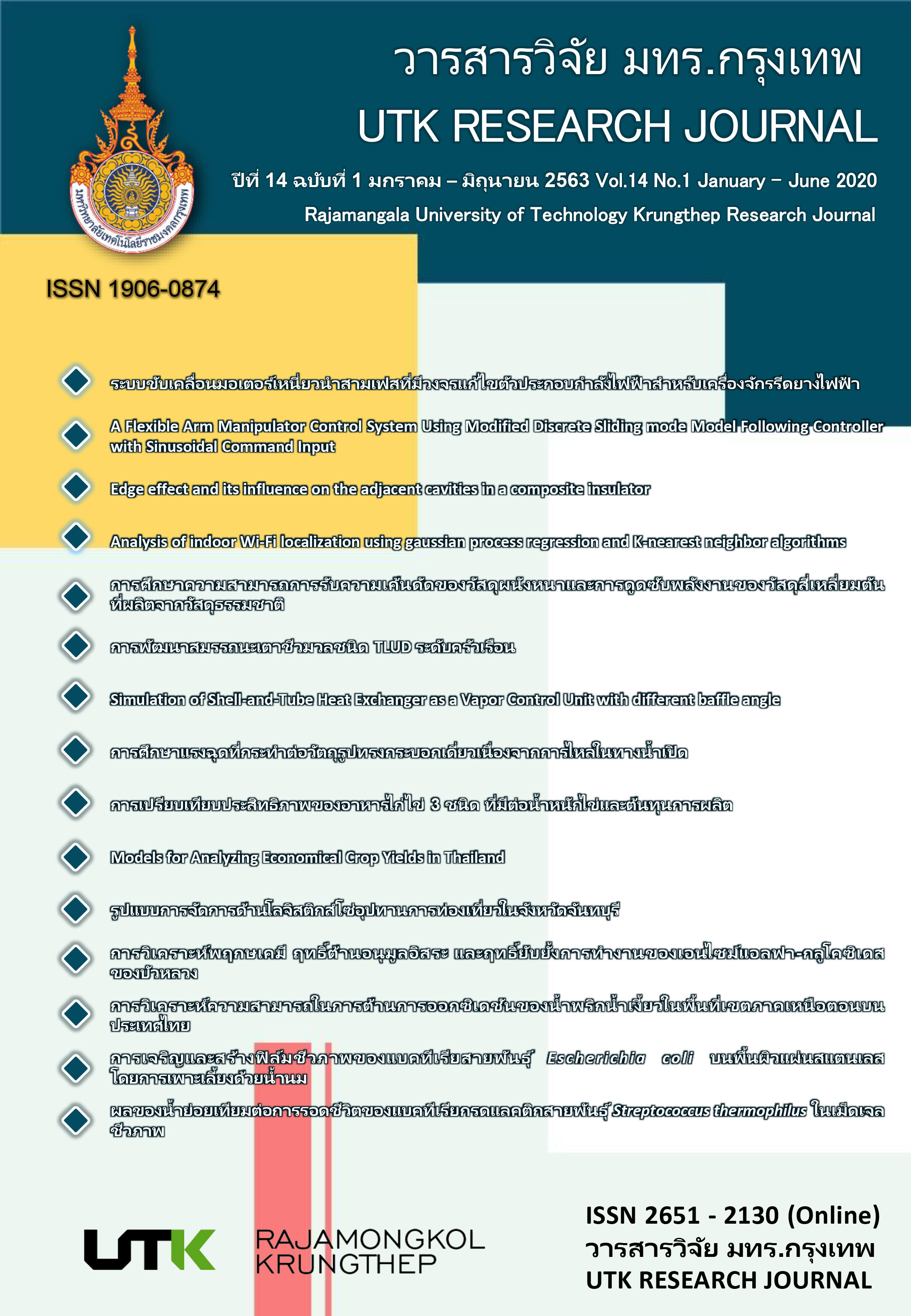Analysis of indoor Wi-Fi localization using gaussian process regression and K-nearest neighbor algorithms
Keywords:
Fingerprint, Wi-Fi, Gaussian process regression, K-nearest neighbor, Received signal strength indicator, Indoor localizationAbstract
Global positioning system (GPS) cannot well localize in indoor environment. Nowadays, indoor Wi-Fi localization is very attractive in positioning and localization research areas because of existing Wi-Fi infrastructure can be used to conduct, so there is no need extra hardware requirements and cost is not expensive. In indoor Wi-Fi localization, the received signal strength indicator (RSSI) fingerprinting played a key role in the access point performance services. This paper proposed the accuracy analysis of indoor Wi-Fi signal based on localization using machine learning approach. Four accept points (APs) were used to measure RSSI and the measured RSSI data were configured as RSSI fingerprint database which was composed of RSSI data of each AP and the position of receiver point. Four corridors which has 1m x 1m has were researched for indoor Wi-Fi localization. 3000 training RSSI and 234 testing RSSI data points were applied in indoor localization. The machine learning algorithms: Gaussian process regression (GPR) and K-nearest neighbor (KNN) approaches were proposed to analyze the accuracy of indoor localization. The results of Wi-Fi localization accuracy were shown using GPR and KNN in indoor environment. The accuracy and mean square error were discussed for indoor Wi-Fi based on GPR and KNN. In this proposed Wi-Fi indoor localization, the accuracy using GPR performed 75%. Moreover, the accuracy using KNN was 83% when K neighbor value was five. When K neighbor value was 10, the accuracy also outperformed 83%. Finally, according to the results, the analysis of corridors using KNN could provide more accuracy than GPR for testing environment in this study.
References
Wang C, Kao T, Fang S, et al. Robust Wi-Fi Location Fingerprinting Against Device Diversity Based on Spatial Mean Normalization. Proceedings of Asia-Pacific Signal and Information Processing Association Annual Sumit and Conference (APSIPA ASC ) [Internet]. Kaohsiung, Taiwan; 2013. Available from: http://hb.diva-portal.org/smash/get/diva2:1095554/FULLTEXT01.pdf
Zafari F, Gkelias A, Leung King K, A Survey of Indoor Localization Systems and Technologies, IEEE Communications Surveys and Tutorials, 2019. p 2568 - 99.
Akram BA, Akbar A, Wi-Fi Fingerprinting Based Room Level Indoor Localization Framework Using Ensemble Classifiers. [Internet]. Mehran,2019. DOI: 10.22581/muet 1982.1901.13.
Duvallet F, Tews A D, WiFi Position Estimation in Industrial Environments Using Gaussian Processes. [Internet]. IEEE; 2008: DOI: 10.1109/IROS. 2008.4650910.
Mascharka D, Manley E, Machine Learning for Indoor Localization Using Mobile Phone-Based Sensors[Internet]. 2015. Available from: https://arxiv.org/pdf/1505.06125.pdf
Wu Z, Xu Q, Li J, et al. Passive Indoor Localization Based on CSI and Naive Bayes Classification. [Internet]. IEEE; 2018. DOI: 10.1109/TSMC.2017.2679725.
Christoffer O, Tobias O, The precision of RSSI-fingerprinting based on connected Wi-Fi devices [dissertation]. Högskolan i Borås; 2017.
Amirsoori S, Daud SM, Ahmad N A, et al. WI-FI Based Indoor Positioning Using Fingerprinting Methods (KNN Algorithm) in Real Environment. International[Internet]. Journal of Future Generation Communication and Networking. 2017; 10(9): 23-36 Avialable from: http://dx.doi.org/10.14257/ijfgcn.2017.10.9.03.
Rasmussen CE, Gaussian processes in machine learning, in Advanced Lectures on Machine Learning[Internet]. https://www.cs.ubc.ca/~hutter/EARG.shtml/earg/papers05/rasmussen_gps_in_ml.pdf
Ding X, Gao L, Wang Z, Modified Fingerprinting Algorithm for Indoor Location[Internet], Journal of Communications. 2017; 12(3): 145-51 Available from: http://www.jocm.us/uploadfile/2017/0331/20170331050729488.pdf.
Downloads
Published
How to Cite
Issue
Section
License
กองบรรณาธิการวารสารวิชาการ มหาวิทยาลัยเทคโนโลยีราชมงคลกรุงเทพ มีความยินดีที่จะรับบทความจากอาจารย์ นักวิจัย นักวิชาการทั้งภายในและภายนอกมหาวิทยาลัย ในสาขาวิชาวิทยาศาสตร์และเทคโนโลยี ได้แก่ สาขาวิชาวิทยาศาสตร์ วิศวกรรมศาสตร์ และสาขาอื่นๆ ที่เกี่ยวข้อง รวมถึงสาขาต่างๆ ที่มีการบูรณาการข้ามศาสตร์ที่เกี่ยวข้องวิทยาศาสตร์และเทคโนโลยี ที่เขียนเป็นภาษาไทยหรือภาษาอังกฤษ ซึ่งผลงานวิชาการที่ส่งมาขอตีพิมพ์ต้องไม่เคยเผยแพร่ในสิ่งพิมพ์อื่นใดมาก่อน และต้องไม่อยู่ในระหว่างการพิจารณาของวารสารอื่น
การละเมิดลิขสิทธิ์ถือเป็นความรับผิดชอบของผู้ส่งบทความโดยตรง บทความที่ได้รับการตีพิมพ์ต้องผ่านการพิจารณากลั่นกรองคุณภาพจากผู้ทรงคุณวุฒิและได้รับความเห็นชอบจากกองบรรณาธิการ
ข้อความที่ปรากฏอยู่ในแต่ละบทความที่ตีพิมพ์ในวารสารวิชาการเล่มนี้ เป็นความคิดเห็นส่วนตัวของผู้เขียนแต่ละท่าน ไม่เกี่ยวข้องกับมหาวิทยาลัยเทคโนโลยีราชมงคลกรุงเทพแต่อย่างใด ความรับผิดชอบด้านเนื้อหาและการตรวจร่างบทความแต่ละบทความเป็นของผู้เขียนแต่ละท่าน หากมีความผิดพลาดใดๆ ผู้เขียนแต่ละท่านจะต้องรับผิดชอบบทความของตนเองแต่ผู้เดียว
กองบรรณาธิการขอสงวนสิทธิ์มิให้นำเนื้อหา หรือข้อคิดเห็นใดๆ ของบทความในวารสารวิชาการ มหาวิทยาลัยเทคโนโลยีราชมงคลกรุงเทพ ไปเผยแพร่ก่อนได้รับอนุญาตจากกองบรรณาธิการ อย่างเป็นลายลักษณ์อักษร ผลงานที่ได้รับการตีพิมพ์ถือเป็นลิขสิทธิ์ของวารสาร






